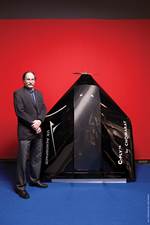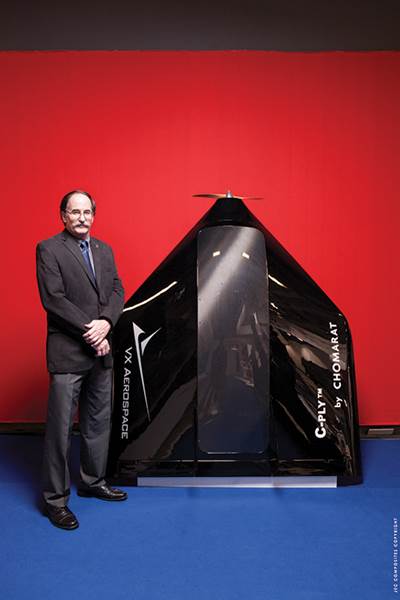VX-1 KittyHawk first flight video
Successful first flight test matches computer predictions and enables virtual testing of next refinements.

The VX-1 KittyHawk 1/4-scale model completes first flight test. SOURCE: VX Aerospace
The VX-1 KittyHawk is a blended wing body aircraft made by VX Aerospace (Morganton, N.C., USA) using C-ply advanced carbon fabrics from Chomarat North America (Anderson, S.C.). The aircraft offers structural efficiency, lightweight and unusually large payload space as an unmanned aerial vehicle (UAV) or cargo space as a sport aircraft. This combination of design and large volume allow the KittyHawk to incorporate compressed natural gas (CNG) as a fuel with no aerodynamic compromise, and thus, the potential to provide new levels of fuel efficiency and emissions reductions.
A ¼ scale model recently completed the aircraft’s first flight test and performed well. “The test flight showed that the plane is dynamically stable and that the control systems work well,” said VX Aerospace Chief Engineer Bob Skillen. “It confirms the aircraft’s potential and we are processing the data to plan our next flight test in late summer.”
Skillen describes the aircraft as “dynamically stable” but in the video below, the airplane model looks very “tippy”. Skillen explains, “"Every motion you see the airplane make in the video is in response to a pilot input. It's the first time this shape has ever been flown. It takes a few moments for the pilot and aircraft to become acquainted. Also, a lot of the maneuvers were intentional for control system/response data."
Lars Soltmann, a Ph.D. student at North Carolina State University (NCSU, Raleigh, N.C., USA) and UAV researcher who performed the computational fluid dynamics (CFD) analysis on the KittyHawk, explained that lifting body designs (blended wing body aircraft) can be a bit “twitchy” because of the lack of damping from a tail. “Also, flying wings generally have a lower pitching moment of inertia because their mass is less spread out vs. traditional aircraft designs,” he adds. “Stability can be increased by shifting the center of gravity forward.” So a bit of modification will take place before the next test flight.
Skillen points out that the team can actually play with a variety of design changes to the aircraft and then test them virtually in the computer. “This is possible because the flight data collected matches perfectly with the CFD and wind tunnel projections generated by Lars.” Soltmann expounds, “Bob gave me a shape and other details, and I put that through CFD computations. Then we 3-D printed a model of the aircraft, with a 1-ft wingspan, and tested that in the wind tunnel. The data matched almost on top of each other.” This confidence in their performance predictions and a now well-established baseline is what will enable the team to refine the VX-1 KittyHawk with virtual testing until they are ready to flight test again.
The test pilot, R.J. Gritter, is also from N.C. State and is a very experienced full-scale aircraft pilot as well as an expert remote control/unmanned aerial vehicle pilot, winning several championships and representing Team USA in the next international radio control aerobatics competition.
The dives mentioned above are called pitch doublets, where RJ pulls back on the stick, holds, pushes forward, holds and then returns back to neutral. “These excite longitudinal aircraft modes that we then compare back to the computer simulations,” explains Soltmann. Again, the test data looks good and the team has a clear idea of what they need to do next.
Related Content
Manufacturing the MFFD thermoplastic composite fuselage
Demonstrator’s upper, lower shells and assembly prove materials and new processes for lighter, cheaper and more sustainable high-rate future aircraft.
Read MoreSulapac introduces Sulapac Flow 1.7 to replace PLA, ABS and PP in FDM, FGF
Available as filament and granules for extrusion, new wood composite matches properties yet is compostable, eliminates microplastics and reduces carbon footprint.
Read MorePlant tour: Albany Engineered Composites, Rochester, N.H., U.S.
Efficient, high-quality, well-controlled composites manufacturing at volume is the mantra for this 3D weaving specialist.
Read MorePEEK vs. PEKK vs. PAEK and continuous compression molding
Suppliers of thermoplastics and carbon fiber chime in regarding PEEK vs. PEKK, and now PAEK, as well as in-situ consolidation — the supply chain for thermoplastic tape composites continues to evolve.
Read MoreRead Next
VX Aerospace: Small company, big performance
Innovative design, OOA manufacturing and C-PLY laminate construction produce “big fabricator” aerostructures in fewer steps at low cost.
Read MorePlant tour: Daher Shap’in TechCenter and composites production plant, Saint-Aignan-de-Grandlieu, France
Co-located R&D and production advance OOA thermosets, thermoplastics, welding, recycling and digital technologies for faster processing and certification of lighter, more sustainable composites.
Read MoreAll-recycled, needle-punched nonwoven CFRP slashes carbon footprint of Formula 2 seat
Dallara and Tenowo collaborate to produce a race-ready Formula 2 seat using recycled carbon fiber, reducing CO2 emissions by 97.5% compared to virgin materials.
Read More





















